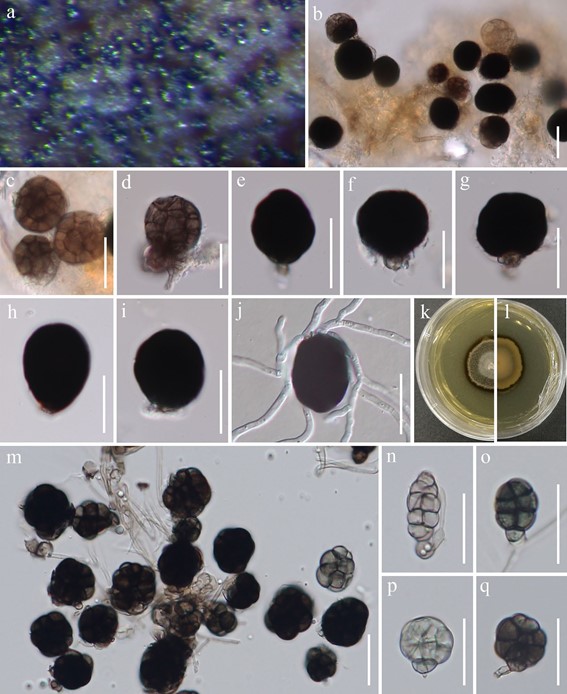Neomonodictys muriformis Y.Z. Lu, C.G. Lin & K.D. Hyde, sp. nov.
MycoBank number: MB 556731; Index Fungorum number: IF 556731; Facesoffungi number: FoF 06819; Fig. 133
Etymology: Name reflects its muriform conidia.
Holotype: MFLU 17-1178
Saprobic on decaying wood in a freshwater stream. Sexual morph Undetermined. Asexual morph Hyphomycetous, dictyosporous. Colonies on natural substratum superficial, scattered, black, glistening. Mycelium immersed in the substrate, composed of septate, branched, smooth, thin- walled, hyaline to pale brown, 2–3 μm wide hyphae. Con- idiophores lacking. Conidiogenous cells holoblastic, monoblastic, integrated, terminal, determinate, brown. Conidia 20–30 × 15–25 μm ( x̄ = 22 × 20 μm, n = 20), acrogenous, solitary, subglobose to globose, muriform, smooth-walled, pale brown when immature, darkened to black when mature, sometimes with one basal cell paler than the others.
Culture characteristics: Conidia germinating on WA and germ tubes produced from conidia within 36 h. Colonies growing on MEA, circular, with flat surface, edge entire, reaching 19 mm in 6 weeks at 28 °C, pale brown to brown in MEA medium. Mycelium superficial and partially immersed, branched, septate, hyaline to pale brown, smooth. Material examined: THAILAND, Krabi Province, Plai Praya, Khao To, Ban Bang Thao Mae, on submerged decaying wood in a freshwater stream, 17 December 2015, S. Boonmee, BTM05-4 (MFLU 17-1178, holotype), ex-type living culture, MFLUCC 16-1136.
GenBank numbers: ITS =MN644509, LSU =MN644485, TEF1-α = MN646856.

Fig. 133 Neomonodictys muriformis (MFLU 17-1178, holotype). a Colonies on decaying woody substrate. b–i Conidia on decaying woody substrate. j Germinating conidium. k, l Colony on MEA from above and below. m–q Conidia on living culture. Scale bars: b–j, m–q = 20 µm
